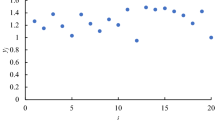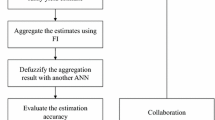Abstract
Forecasting factory productivity is a critical task. However, it is not easy owing to the uncertainty of productivity. Existing methods often forecast productivity using a fuzzy number. However, the range of a fuzzy productivity forecast is wide owing to the consideration of extreme cases. In this study, a fuzzy collaborative forecasting approach is proposed to forecast factory productivity using a type-II fuzzy number and by narrowing the forecast’s range. The outer section of the type-II fuzzy number determines the range of productivity, while the inner section is defuzzified to derive the most likely value. Based on the experimental results, the proposed methodology surpassed existing methods in improving forecasting precision and accuracy, with a reduction in the mean absolute percentage error (MAPE) of up to 74%.













Similar content being viewed by others
References
Akano TT, Asaolu OS (2017) Productivity forecast of a manufacturing system through intelligent modelling. Futo J Ser 3(1):102–113
Baumers M, Dickens P, Tuck C, Hague R (2016) The cost of additive manufacturing: machine productivity, economies of scale and technology-push. Technol Forecast Soc Chang 102:193–201
Chen T (2018) Fitting an uncertain productivity learning process using an artificial neural network approach. Comput Math Organiz Theory 24(3):422–439
Chen T, Lin YC (2008) A fuzzy-neural system incorporating unequally important expert opinions for semiconductor yield forecasting. Int J Uncertain Fuzz Knowledge-Based Syst 16(1):35–58
Chen T, Wang YC (2013) Semiconductor yield forecasting using quadratic-programming-based fuzzy collaborative intelligence approach. Math Prob Eng 672404:1–7
Chen T, Wang YC (2014) An agent-based fuzzy collaborative intelligence approach for precise and accurate semiconductor yield forecasting. IEEE Trans Fuzzy Syst 22(1):201–211
Chen T, Wang YC (2016) Evaluating sustainable advantages in productivity with a systematic procedure. Int J Adv Manuf Technol 87(5–8):1435–1442
Chen T, Wang YC (2020) Interval fuzzy number-based approach for modeling an uncertain fuzzy yield learning process. J Ambient Intell Humaniz Comput 11:1213–1223
Chen TCT, Wang YC, Huang CH (2020) An evolving partial consensus fuzzy collaborative forecasting approach. Mathematics 8(4):554
Chiu MC, Chen TCT, Hsu KW (2020) Modeling an uncertain productivity learning process using an interval fuzzy methodology. Mathematics 8(6):998
Crabtree J (2015) Foxconn to build up to 12 factories, employ 1M in India. https://www.cnbc.com/2015/07/14/apple-manufacturer-foxconn-to-build-12-factories-employ-1m-in-india.html
Dahooie JH, Zavadskas EK, Abolhasani M, Vanaki A, Turskis Z (2018) A novel approach for evaluation of projects using an interval-valued fuzzy additive ratio assessment (ARAS) method: a case study of oil and gas well drilling projects. Symmetry 10(2):45
Dimuro GP (2011) On interval fuzzy numbers. In: 2011 workshop-school on theoretical computer science. IEEE, pp 3–8
Donoso S, Marín N, Vila MA (2006) Quadratic programming models for fuzzy regression. In: Proceedings of international conference on mathematical and statistical modeling in honor of Enrique Castillo
Enayattabar M, Ebrahimnejad A, Motameni H (2019) Dijkstra algorithm for shortest path problem under interval-valued Pythagorean fuzzy environment. Complex Intell Syst 5(2):93–100
Garg H (2019) Neutrality operations-based Pythagorean fuzzy aggregation operators and its applications to multiple attribute group decision-making process. J Ambient Intell Humaniz Comput 11:3021–3041
Grabner C, Klein P, Lödding H (2019) Success forecast for productivity methods-How companies can predict the impact of methods on labour productivity. ZWF Zeitschrift fuer Wirtschaftlichen Fabrikbetrieb 114(3):105–109
Gruber H (1994) Learning and strategic product innovation: theory and evidence for the semiconductor industry. Elsevier Science B. V, The Netherlands
Jorgenson D, Gollop FM, Fraumeni B (2016) Productivity and US economic growth. Elsevier, North-Holland
Joshi R (2020) A new multi-criteria decision-making method based on intuitionistic fuzzy information and its application to fault detection in a machine. J Ambient Intell Humaniz Comput 11(2):739–753
Lin YC, Chen T (2019) An advanced fuzzy collaborative intelligence approach for fitting the uncertain unit cost learning process. Complex Intell Syst 5(3):303–313
Lin YC, Wang YC, Chen TCT, Lin HF (2019) Evaluating the suitability of a smart technology application for fall detection using a fuzzy collaborative intelligence approach. Mathematics 7(11):1097
Mankins M (2017) Great companies obsess over productivity, not efficiency. Harvard Bus Rev 3:1–5
Mirahadi F, Zayed T (2016) Simulation-based construction productivity forecast using neural-network-driven fuzzy reasoning. Autom Construct 65:102–115
Peters G (1994) Fuzzy linear regression with fuzzy intervals. Fuzzy Sets Syst 63:45–55
Repina E, Simonova M, Sukhanova E (2019) The development of a forecast model of labour productivity management at industrial enterprises. In: 2nd international scientific conference on new industrialization: global, national, regional dimension (SICNI 2018). Atlantis Press
Stevenson WJ, Sum CC (2014) Operations management. McGraw-Hill/Irwin, New York
Tanaka H, Watada J (1988) Possibilistic linear systems and their application to the linear regression model. Fuzzy Sets Syst 272:275–289
Uluçay V, Deli I, Şahin M (2019) Intuitionistic trapezoidal fuzzy multi-numbers and its application to multi-criteria decision-making problems. Complex Intell Syst 5(1):65–78
Wang YC, Chen T (2013) A fuzzy collaborative forecasting approach for forecasting the productivity of a factory. Adv Mech Eng 5:234571
Wang YC, Chen T, Lin YC (2019) A collaborative and ubiquitous system for fabricating dental parts using 3D printing technologies. Healthcare 7(3):103
Wei Y, Watada J (2012) Building a type ii fuzzy qualitative regression model. In: Watada J, et al. (eds) Intelligent decision technologies, vol 1. Springer, Heidelberg, pp 145–154
Wu HC, Chen T (2015) CART–BPN approach for estimating cycle time in wafer fabrication. J Ambient Intell Humaniz Comput 6(1):57–67
Yu W, Zhang Z, Zhong Q (2019) Consensus reaching for MAGDM with multi-granular hesitant fuzzy linguistic term sets: a minimum adjustment-based approach. Ann Oper Res. https://doi.org/10.1007/s10479-019-03432-7
Zhang C, Wang C, Zhang Z, Tian D (2019a) A novel technique for multiple attribute group decision making in interval-valued hesitant fuzzy environments with incomplete weight information. J Ambient Intell Humaniz Comput 10(6):2417–2433
Zhang Z, Yu W, Martinez L, Gao Y (2019b) Managing multigranular unbalanced hesitant fuzzy linguistic information in multiattribute large-scale group decision making: a linguistic distribution-based approach. IEEE Trans Fuzzy Syst. https://doi.org/10.1109/TFUZZ.2019.2949758
Zhang ZX, Wang L, Rodríguez RM, Wang YM, Martínez L (2017) A hesitant group emergency decision making method based on prospect theory. Complex Intell Syst 3(3):177–187
Acknowledgements
This study was sponsored by the Ministry of Science and Technology, Taiwan.
Author information
Authors and Affiliations
Corresponding author
Additional information
Publisher's Note
Springer Nature remains neutral with regard to jurisdictional claims in published maps and institutional affiliations.
Rights and permissions
About this article
Cite this article
Chen, T., Wang, YC. & Chiu, MC. A type-II fuzzy collaborative forecasting approach for productivity forecasting under an uncertainty environment. J Ambient Intell Human Comput 12, 2751–2763 (2021). https://doi.org/10.1007/s12652-020-02435-8
Received:
Accepted:
Published:
Issue Date:
DOI: https://doi.org/10.1007/s12652-020-02435-8




